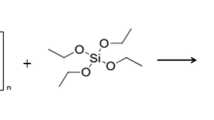Abstract
The uses of low cost, renewable, environmentally friendly chitosan biopolymer as the structural template to control the size of silica particles in the range of nanometer scales are attractive for their practical industrial applications. In this paper, the nanostructured silica was synthesized using sodium silicate as the silica source and chitosan as the template under mild conditions. Effects of chitosan/silica ratio and aging temperature on the formation and the control of nanostructured silica was investigated by using thermal gravimetric analysis (TGA), scanning electron microscopy (SEM), N2-sorption measurement, and transmission electron microscopy (TEM). It was found that the silica products were composed of the aggregates of primary silica nanoparticles and nanostructured silica units. At low aging temperature, the size of nanostructured silica was decreased when increasing the chitosan/silica ratio from 0.1 to 0.4. In contrast, the reverse trend was observed at the chitosan/silica ratio of higher than 0.4. The increase of aging temperature led to the formation of larger primary silica nanoparticles and nanostructured silica, and also promoted the formation of silica/chitosan composites. The fractal dimension calculated using modified FHH method found the linear correlation at two different regimes which might reflect the aggregates of silica products at different length scales.






Similar content being viewed by others
References
Iler RK (1979) The chemistry of silica. Wiley, New York
Brinker CJ, Scherer GW (1990) Sol-gel science: the physics and chemistry of sol–gel processing. Academic Press, New York
Rolison DR (2003) Science 299:1698–1701
Zhai SR, Ha CS (2007) Micropor Mesopor Mater 102:212–222
Knecht MR, Sewell SL, Wright DW (2005) Langmuir 21:2058–2061
Yang Y, Coradin T (2008) Green Chem 10:183–190
Belton D, Paine G, Patwardhan SV, Perry CC (2004) J Mater Chem 14:2231–2241
Patwardhan SV, Maheshwari R, Mukherjee N, Kiick KL, Clarson SJ (2006) Biomacromolecules 7:491–497
Knecht MR, Wright DW (2004) Chem Mater 16:4890–4895
Snyder MA, Lee JA, Davis TM, Scriven LE, Tsapatsis M (2007) Langmuir 23:9924–9928
Li X, Yang T, Gao Q, Yuan J, Cheng S (2009) J Colloid Interface Sci 338:99–104
Witoon T, Chareonpanich M, Limtrakul J (2009) J Sol–Gel Sci Technol 51:146–152
Leng B, Chen X, Shao Z, Ming W (2008) Small 6:755–758
Puchol V, El Haskouri J, Latorre J, Guillem C, Beltrán A, Beltrán D, Amorós P (2009) Chem Commun 19:2694–2696
Pfeifer P, Liu KY, Rudzinski W, Steele WA, Zgrablich G (1997) Equilibria and dynamics of gas adsorption on heterogeneous solid surfaces. Elsevier, New York
Ismail IMK, Pfeifer P (1994) Langmuir 10:1532–1538
Domard A, Domard M (2002) In: Dumitriu S (ed) Polymeric biomaterials, 2nd edn. Marcel Dekker, New York
Prouzet E, Boissière C, Kim SS, Pinnavaia TJ (2009) Micropor Mesopor Mater 119:9–17
Meng F, Schlup JR, Fan LT (1998) J Colloid Interface Sci 197:88–93
Balathanigaimani MS, Shim WG, Kim C, Lee JW, Moon H (2009) Surf Interface Anal 41:484–488
Lee CK, Tsay CS (1998) J Phys Chem B 102:4123–4130
Tang P, Chew NYK, Chan HK, Raper JA (2003) Langmuir 19:2632–2638
Esquena J, Solans C, Llorens J (2000) J Colloid Interface Sci 225:291–298
Pfeifer P, Avnir D (1983) J Chem Phys 79:3558–3565
Avnir D, Farin D, Pfeifer P (1983) J Chem Phys 79:3566–3571
Acknowledgments
This work was financially supported by the Thailand Research Fund through the Royal Golden Jubilee Ph.D. Program (Grant No. PHD/0012/2548), the National Science and Technology Development Agency (NSTDA Chair Professor and NANOTEC Center of Excellence) under the Postgraduate Education, and Research Programs in Petroleum and Petrochemicals, and Advanced Materials.
Author information
Authors and Affiliations
Corresponding author
Electronic supplementary material
Below is the link to the electronic supplementary material.
Rights and permissions
About this article
Cite this article
Witoon, T., Chareonpanich, M. & Limtrakul, J. Size control of nanostructured silica using chitosan template and fractal geometry: effect of chitosan/silica ratio and aging temperature. J Sol-Gel Sci Technol 56, 270–277 (2010). https://doi.org/10.1007/s10971-010-2303-9
Received:
Accepted:
Published:
Issue Date:
DOI: https://doi.org/10.1007/s10971-010-2303-9




